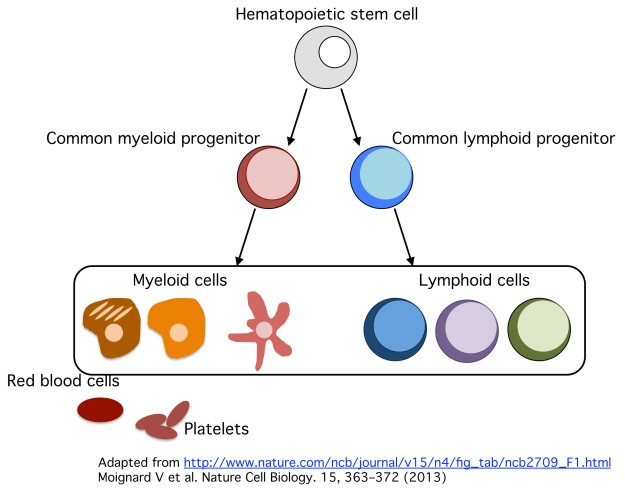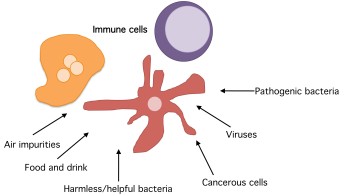Where do immune cells come from?
Before we get into the logistics of how the cells of our immune system do their jobs, let’s talk about where they come from. You may be more familiar with the term white blood cells, which also describes immune cells. White blood cells share a common ancestor with red blood cells and platelets, the hematopoietic stem cell.
Hematopoietic stem cells
The term stem cell has become loaded with political baggage recently, but has a rather simple definition. When a stem cell undergoes cell division, which is to say it splits into two cells, it makes one stem cell (self-renewal) and one cell that is more specialized or developed. Self-renewal and the ability to give rise to all the cells in a family (for instance, all blood cells) are the hallmarks of stem cells. The hematopoietic stem cell (HSC) is able to make all the cells in the hematopoietic (or blood) family. HSCs are typically found in the bone marrow, the inner core of the bones.
Progenitors
When HSCs divide to give rise to one HSC and one more committed cell, the more committed cell is termed a progenitor. A progenitor is not a stem cell, as it can no longer give rise to all of the blood cells. A progenitor is also not a mature immune cell, ready to do battle with an infection. It is at an intermediate phase, capable of making a variety of closely related cells, but no longer able to make more distantly related cells.
In the bone marrow, common myeloid progenitors give rise to myeloid cells, the early response team of the immune system, as well as red blood cells and platelets. Common lymphoid progenitors make lymphoid cells, including B cells, natural killer cells, and T cells. However, the bone marrow cannot make T cells. Lymphoid progenitors have to leave the bone marrow, travel through the bloodstream, and go to the thymus, an organ that specializes in making T cells.
We’ll build on these concepts and diagrams as we go. All questions welcomed in the comments!
<p><span style=”display:none”>claimtoken-5357cf15993bb</span></p>

